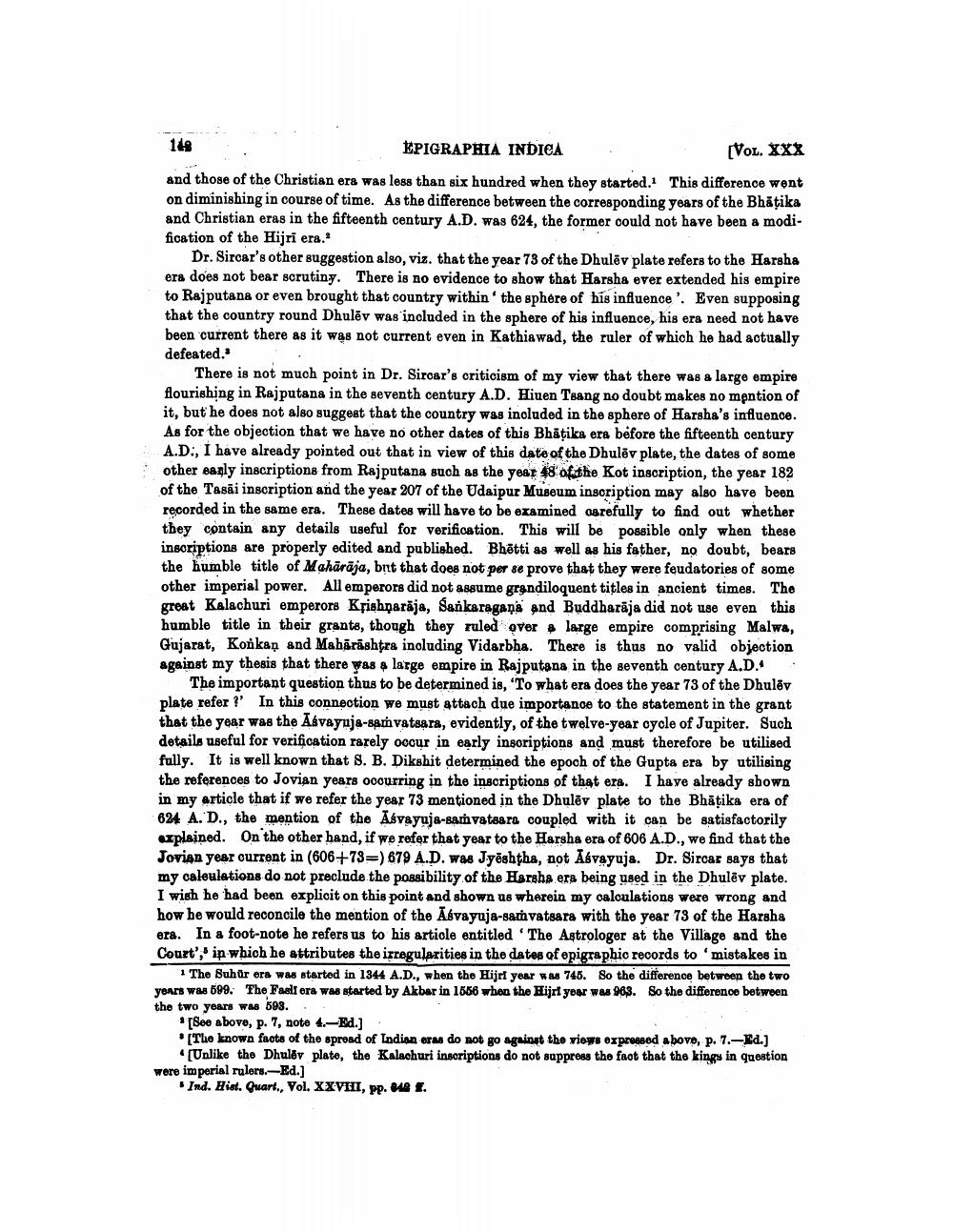________________
EPIGRAPHIA INDICA
[VOL. XXX and those of the Christian era was less than six hundred when they started. This difference went on diminishing in course of time. As the difference between the corresponding years of the Bhatika and Christian eras in the fifteenth century A.D. was 624, the former could not have been a modification of the Hijri era.
Dr. Sircar's other suggestion also, viz. that the year 73 of the Dhulēv plate refers to the Harsha era does not bear scrutiny. There is no evidence to show that Harsha ever extended his empire to Rajputana or even brought that country within the sphere of his influence'. Even supposing that the country round Dhulēv was included in the sphere of his influence, his era need not have been current there as it was not current even in Kathiawad, the ruler of which he had actually defeated."
There is not much point in Dr. Sircar's criticism of my view that there was a large empire flourishing in Rajputana in the seventh century A.D. Hiuen Tsang no doubt makes no mention of it, but he does not also suggest that the country was included in the sphere of Harsha's influence. As for the objection that we have no other dates of this Bhäţika era before the fifteenth century A.D., I have already pointed out that in view of this date of the Dhulēv plate, the dates of some other early inscriptions from Rajputana such as the year 18 of the Kot inscription, the year 182 of the Taski inscription and the year 207 of the Udaipur Museum inscription may also have been recorded in the same era. These dates will have to be examined carefully to find out whether they contain any details useful for verification. This will be possible only when these inscriptions are properly edited and published. Bhētti as well as his father, no doubt, bears the humble title of Mahārāja, bnt that does not per se prove that they were feudatories of some other imperial power. All emperors did not assume grandiloquent titles in ancient times. The great Kalachuri emperors Krishnarāja, Sarkaragana and Buddharāja did not use even this humble title in their grants, though they ruled over a large empire comprising Malwa, Gujarat, Konkan and Maharashtra including Vidarbha. There is thus no valid objection against my thesis that there was a large empire in Rajputana in the seventh century A.D.
The important question thus to be determined is, 'To what era does the year 73 of the Dhulēv plate refer ?' In this connection we must attach due importance to the statement in the grant that the year was the Advayuja-samvatsara, evidently, of the twelve-year cycle of Jupiter. Such details useful for verification rarely occur in early insoriptions and must therefore be utilised fully. It is well known that S. B. Dikshit determined the epoch of the Gupta era by utilising the references to Jovian years oocurring in the inscriptions of that era. I have already shown in my article that if we refer the year 73 mentioned in the Dhulēv plate to the Bhäţika era of 624 A. D., the mention of the Asvayuja-samvatsara coupled with it can be satisfactorily explained. On the other hand, if we refer that year to the Harsha era of 606 A.D., we find that the Jovian year current in (606+73=) 679 A.D.w38 Jy shtha, not Åsvayuja. Dr. Sircar says that my caleulations do not preclude the possibility of the Harsha era being used in the Dhulēv plate. I wish he had been explicit on this point and shown us wherein my calculations were wrong and how be would reconcile the mention of the Asvayuja-samvatsara with the year 73 of the Harsha era. In a foot-note he refers us to his article entitled 'The Astrologer at the Village and the Court', in which he attributes the irregularities in the dates of epigraphic records to 'mistakes in
1 The Buhör era was started in 1344 A.D., when the Hijrt year was 745. So the difference between the two years was 599. The Fasli ora was started by Akbar in 1556 when the Hijrt year was 983. So the difference between the two years was 699.. . *[See above, p. 7, note 4.-Ed.).
The known facts of the spread of Indian erm do not go against the viowe oxpressed above, p. 7.-d.)
(Unlike the Dhuldy plato, the Kalachuri inscriptions do not suppress the fact that the kings in question were imperial rulers.--Ed.]
Ind. Hist. Quart., Vol. XXVHI, pp. We f.




